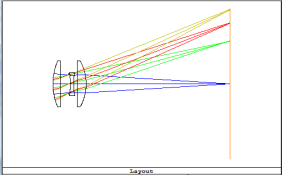Nodda Duma
Member
This is posted on LFF as well. Not sure if I should post here or in apug's large format subforum, but I flipped a coin and it came up tails, so...
Yesterday was kind of slow at work, so I played in Zemax while I worked on some other stuff. Basically I was wondering if I could design a Cooke Triplet in a reasonable large format focal length using lenses you can buy out of a catalog. I figured some intrepid DIY'er might be interested in the results and maybe put one together. The lenses are all available from Thorlabs.
There's a limit to what you can do with off-the-shelf optics so don't expect the same quality as a true Cooke. But that aside...
This covers a 4x5 format. Reference the layout for lens orientation (showing f/16 aperture setting).

Focal length: 177 mm.
Sharp on-axis, soft off-axis at f/8
Should be pretty sharp at f/16.
Lens 1: Part # LA1384-A Diameter: 2"
http://www.thorlabs.com/thorproduct....umber=LA1384-A
Airgap between Lens 1 and Aperture stop: 9.0 mm
Airgap between aperture and Lens 2: 2.0 mm
Lens 2: Part # LD4735 Diameter: 1"
http://www.thorlabs.com/thorproduct....tnumber=LD4735
Airgap between lens 2 and lens 3: 4.0
Lens 3: Part # LA1050-A Diameter: 2"
http://www.thorlabs.com/thorproduct....umber=LA1050-A
Back focus is ~156 mm.
Blacken all lens edges with Speedball Black India ink (I forget the part #, you can get it at a crafts store like Michael's).
Notes for lens 1: Mounting should allow for a clear aperture diameter of at least 35mm.
Notes for aperture: The aperture should provide a maximum 22.2 mm for f/8. For the aperture, you can use Waterhouse stops or an off-the-shelf aperture such as Thorlabs D25S: http://www.thorlabs.com/thorproduct.cfm?partnumber=D25S Make sure you maintain the 2mm airgap.
Notes for lens 2: The fused silica material acts as the "flint" I couldn't find a larger diameter lens like this, which limits the f/# to 8. When mounting you need to provide for a clear aperture diameter of 23mm or you'll get vignetting. This gives you about 1mm edge mounting thickness which is sufficient to mount the lens. Alternatively, you can edge bond in a tube with RTV *not* hard epoxy.
Notes for lens 3: Mounting should allow for a clear aperture diameter of at least 33 mm.
The design consists of two outer plano-convex outer lenses (the positive crowns) and an inner equi-concave lens (the negative "flint"). Finding a suitable flint was tough because catalog lenses are made out of either N-BK7 or N-SF11 and the combination of those two is not conducive to color correction. The fused silica of the chosen lens seems to work well, but performance does suffer. A custom lens would help performance quite a bit, but I'm limiting this to what you can buy off-the-shelf.
Blacken the inside of your barrel.
Good luck, have fun, and share the results!
Regards,
Jason
P.S. Feel free to ask questions
Yesterday was kind of slow at work, so I played in Zemax while I worked on some other stuff. Basically I was wondering if I could design a Cooke Triplet in a reasonable large format focal length using lenses you can buy out of a catalog. I figured some intrepid DIY'er might be interested in the results and maybe put one together. The lenses are all available from Thorlabs.
There's a limit to what you can do with off-the-shelf optics so don't expect the same quality as a true Cooke. But that aside...
This covers a 4x5 format. Reference the layout for lens orientation (showing f/16 aperture setting).

Focal length: 177 mm.
Sharp on-axis, soft off-axis at f/8
Should be pretty sharp at f/16.
Lens 1: Part # LA1384-A Diameter: 2"
http://www.thorlabs.com/thorproduct....umber=LA1384-A
Airgap between Lens 1 and Aperture stop: 9.0 mm
Airgap between aperture and Lens 2: 2.0 mm
Lens 2: Part # LD4735 Diameter: 1"
http://www.thorlabs.com/thorproduct....tnumber=LD4735
Airgap between lens 2 and lens 3: 4.0
Lens 3: Part # LA1050-A Diameter: 2"
http://www.thorlabs.com/thorproduct....umber=LA1050-A
Back focus is ~156 mm.
Blacken all lens edges with Speedball Black India ink (I forget the part #, you can get it at a crafts store like Michael's).
Notes for lens 1: Mounting should allow for a clear aperture diameter of at least 35mm.
Notes for aperture: The aperture should provide a maximum 22.2 mm for f/8. For the aperture, you can use Waterhouse stops or an off-the-shelf aperture such as Thorlabs D25S: http://www.thorlabs.com/thorproduct.cfm?partnumber=D25S Make sure you maintain the 2mm airgap.
Notes for lens 2: The fused silica material acts as the "flint" I couldn't find a larger diameter lens like this, which limits the f/# to 8. When mounting you need to provide for a clear aperture diameter of 23mm or you'll get vignetting. This gives you about 1mm edge mounting thickness which is sufficient to mount the lens. Alternatively, you can edge bond in a tube with RTV *not* hard epoxy.
Notes for lens 3: Mounting should allow for a clear aperture diameter of at least 33 mm.
The design consists of two outer plano-convex outer lenses (the positive crowns) and an inner equi-concave lens (the negative "flint"). Finding a suitable flint was tough because catalog lenses are made out of either N-BK7 or N-SF11 and the combination of those two is not conducive to color correction. The fused silica of the chosen lens seems to work well, but performance does suffer. A custom lens would help performance quite a bit, but I'm limiting this to what you can buy off-the-shelf.
Blacken the inside of your barrel.
Good luck, have fun, and share the results!
Regards,
Jason
P.S. Feel free to ask questions















